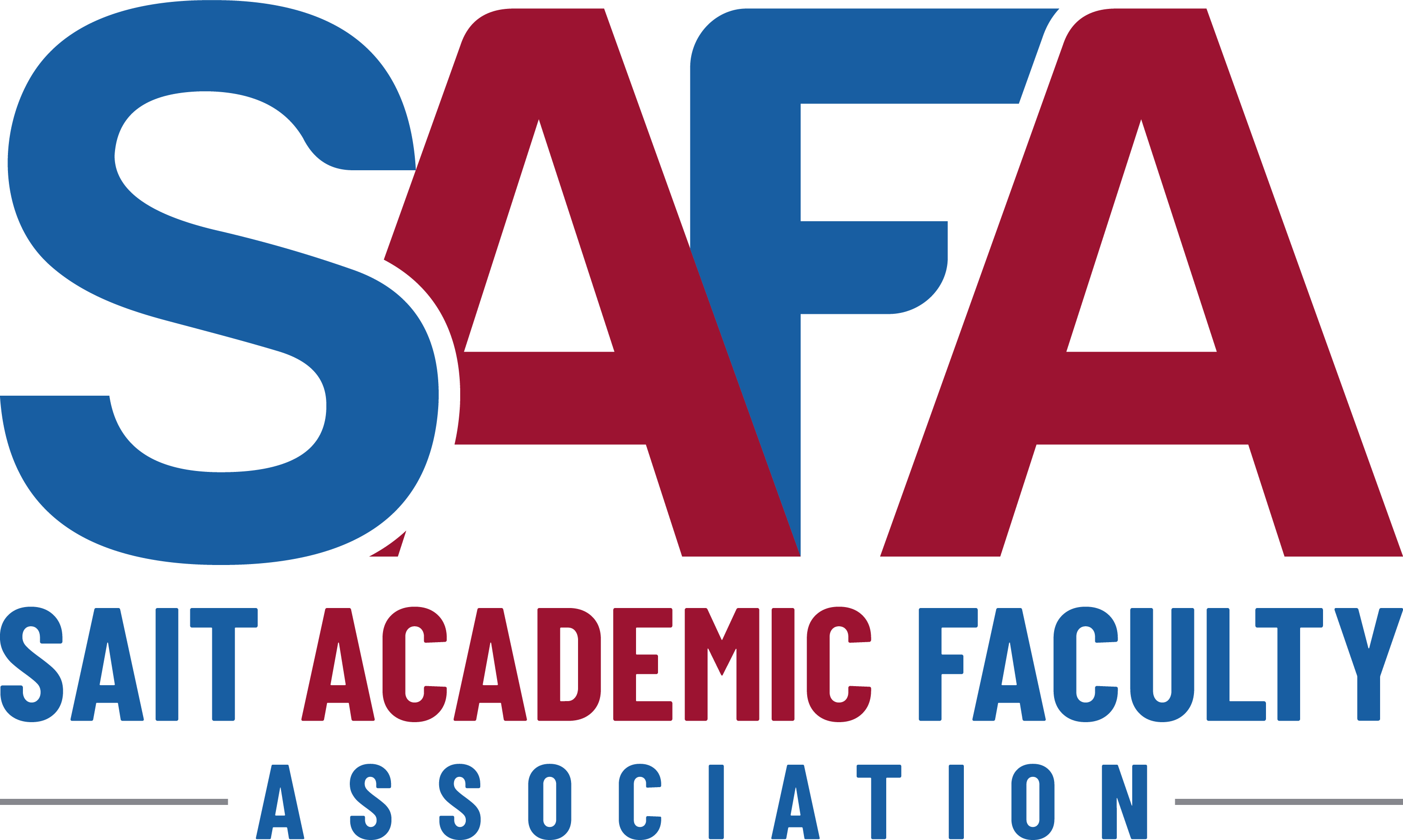The Faculty Association wants to ensure our members have as much information as possible about the process of negotiating a new collective agreement with our employer. Please read through the following general information about the bargaining process.
How does SAFA collective bargaining work?
Step 1: Consultation
In preparation for bargaining, SAFA’s Table of Officers convenes a Negotiating Committee. This Committee includes the Chief Negotiator and faculty members that represent a cross-section of the association’s membership by gender, school, and appointment type.
Ultimately, the Executive is responsible for the conduct of bargaining and related work with the membership. This allows the Negotiating Committee to engage fully in the technical work of negotiations in consultation with the Table of Officers, the professional staff of our affiliates (ACIFA and CAUT), and legal counsel.
The Negotiating Committee consults with membership via surveys, townhall meetings, and individual discussions to develop the bargaining Mandate. This group can also serve as a sounding board to review possible proposals, research current practices, and develop strategies for negotiations with the Employer.
Step 2: Preparing a Proposal
The Negotiating Committee will consult with all members at a General or Special Meeting on our initial bargaining Mandate before we meet with SAIT. The committee reviews the information and perspectives received from all sources and drafts a bargaining Mandate. This draft Mandate is presented for discussion, modification, and approval by the SAFA Executive Council.
Once approved, the Mandate guides the Negotiating Committee through the negotiation process. A good mandate reflects the needs of members, is accountable, and fairly balances individual and collective interests. It also serves as a roadmap for the Bargaining Team as it develops the Association’s initial proposal for presentation to the Employer.
The exchange of initial proposals between the Employer and SAFA can be handled in different ways but SAIT’s chief negotiator has indicated she intends to exchange a complete package of all proposals at the outset of negotiations.
Step 3: Bargaining
During bargaining, the Chief Negotiator becomes the primary conduit through which the Association communicates with the Employer. At the bargaining table, the Association can resolve outstanding grievances and other disputes, can address policy concerns, and can require the Employer to provide financial, personnel, and other information applicable to negotiations.
Bargaining updates are provided to membership after each bargaining meeting. The update paints, in broad strokes, the flavour of the meeting and the topics discussed. However, it doesn’t go into specific details or a “blow by blow” analysis.
Step 4: Reaching a Deal
Through the process of proposal, counter proposal, and negotiation, SAFA and the Employer will work towards a final agreement. However, if SAFA is unable to make progress on important issues, the normal bargaining process provides ways for us to escalate matters and put constructive pressure on the Employer.
At the end of the negotiation process, members get to vote through a secret ballot to accept or reject the new agreement. Similarly, SAIT Board of Governors must also ratify the new Collective Agreement. Both parties must ratify an agreement before it can be implemented.
Definitions
Bargaining – Meetings are scheduled between SAFA Negotiating Committee and SAIT Administration’s bargaining team – Collective Agreement articles are negotiated, clarified, and questions about language are answered.
Essential Services Agreement – Public post-secondary institutions, as it relates to their academic staff, are required to ensure essential services which, if interrupted, would endanger the life, personal safety or health of the public; or are necessary to the maintenance and administration of the rule of law or public security, will be maintained during a strike or lockout. An “Essential Services Agreement” or an exemption is required before either a strike or lockout. Designated essential services workers may not participate in a strike or be locked out.
Mediation – Before a strike or lockout can proceed, the parties need to go through a mediation process. Mediation entails a neutral third party assisting the Association and the employer to reach an agreement. The mediator does not decide an issue. Rather the mediator assists the parties to clarify their positions and reach a compromise. Mediators sometimes write recommendations. These recommendations are not binding and either party is free to accept or reject them.
Lockout – A work stoppage forced by the Employer. This is done to compel the employees to accept a collective agreement (i.e., – SAIT administration prevents us from coming to work).
Strike – A withdrawal of an employee group’s services to an employer. This is a democratic pressure tactic academic staff can use in a unionized environment to get a fair settlement. If the Association hasn’t held a strike vote, a strike cannot legally take place.
Strike Mandate – A strike mandate may not result in a strike. It is a bargaining chip that can be used to secure a better deal at the table. The SAFA Negotiating Committee must receive direct explicit empowerment from the membership in order to be able to carry forth a strike. This means that without a strike mandate, there is very little strength behind each proposal put forth by the Negotiating Committee. Strike mandates are arrived at through a secret ballot election (strike vote) run by SAFA and supervised by the Alberta Labour Relations Board. Before a vote can take place, the parties must have worked with a government-appointed mediator and have had 14 days to consider any recommendations made by the mediator. The majority of those voting must be in favour of a strike mandate in order for the Negotiating Committee to be empowered. The result and turnout of this secret ballot is given to the Executive Committee which decides which information they will release to whom and when.
Ratification – At the end of the negotiation process, members get to vote through a secret ballot to accept or reject the new agreement. Similarly, SAIT Board of Governors must also ratify the Collective Agreement. Both parties must ratify an agreement before it can be implemented.
